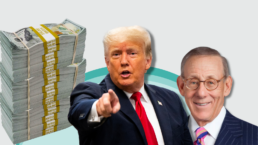Donald Trump and other ultrarich Americans have earned billions, but they’ve also managed to repeatedly avoid paying any federal income tax by claiming huge losses on their businesses.
By Jeff Ernsthausen, Paul Kiel, and Jesse Eisinger, ProPublica
Here’s a tale of two Stephen Rosses.
Real life Stephen Ross, who founded Related Companies, a global firm best known for developing the Time Warner Center and Hudson Yards in Manhattan, was a massive winner between 2008 and 2017. He became the second-wealthiest real estate titan in America, almost doubling his net worth over those years, according to Forbes Magazine’s annual list, by adding $3 billion to his fortune. His assets included a penthouse apartment overlooking Central Park and the Miami Dolphins football team.
Then there’s the other Stephen Ross, the big loser. That’s the one depicted on his tax returns. Though the developer brought in some $1.5 billion in income from 2008 to 2017, he reported even more — nearly $2 billion — in losses. And because he reported negative income, he didn’t pay a nickel in federal income taxes over those 10 years.

What enables this dual identity? The upside-down tax world of the ultrawealthy.
ProPublica’s analysis of more than 15 years of secret tax data for thousands of the wealthiest Americans shows that Ross is one of a special breed.
He is among a subset of the ultrarich who take advantage of owning businesses that generate enormous tax deductions that then flow through to their personal tax returns. Many of them are in commercial real estate or oil and gas, industries that have been granted unusual advantages in the American tax code, which allow the ultrawealthy to take tax losses even on profitable enterprises. Manhattan apartment towers that are soaring in value can be turned into sinkholes for tax purposes. A massively profitable natural gas pipeline company can churn out Texas-sized write-offs for its billionaire owner.
Recent Posts
‘Unconstitutional. Unethical. Authoritarian.’ ICE Bars Millions Of Immigrants From Bond Hearings
July 18, 2025
Take Action Now One watchdog said the new policy “seems like a blatant attempt to stop them from exercising their right to due process.”……
Americans Are Not Nearly Alarmed Enough About Climate Change
July 18, 2025
Take Action Now Americans still don’t comprehend how imminent, dangerous, and far-reaching the threat is—and journalists are partly to blame.By…
The IRS Is Building A Vast System To Share Millions Of Taxpayers’ Data With ICE
July 17, 2025
Take Action Now ProPublica has obtained the blueprint for the Trump administration’s unprecedented plan to turn over IRS records to Homeland Security…
Israel’s Sudden Assault On Syria Is Unchecked Aggression
July 17, 2025
Take Action Now Jerusalem is bombing Damascus and threatening al-Sharaa’s rule, while Washington was hoping to help the nascent government on…




